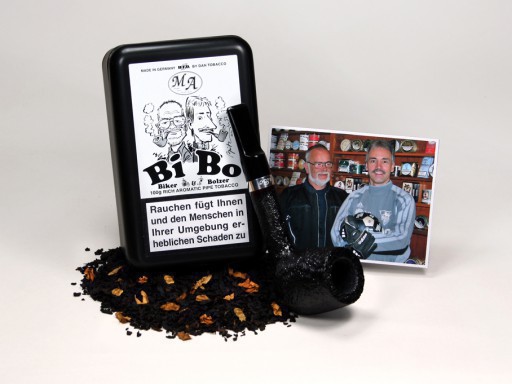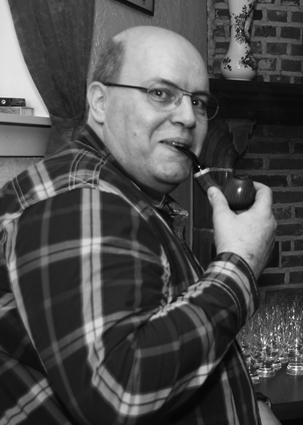Let’s get on to answering the question of part 1 why we don’t smell/taste during smoking what we smelled before in the tobacco pouch:
 When you look at the variety of additives for pipe tobacco, for example to search for those on Wikipedia, you find some difficult descriptions and properties of those additives. Either the natural thing or the artificial. The most important value for our answer is the boiling point of that molecule. If we look up vanilline, it says it has a boiling point of 285 °C (= 558 K [Kelvin] or 545 °F).
When you look at the variety of additives for pipe tobacco, for example to search for those on Wikipedia, you find some difficult descriptions and properties of those additives. Either the natural thing or the artificial. The most important value for our answer is the boiling point of that molecule. If we look up vanilline, it says it has a boiling point of 285 °C (= 558 K [Kelvin] or 545 °F).
 Now, why is that Boiling Point so important? Well, a German friend has asked a chemical engineer to measure the temperature of smouldering tobacco in a pipe and found it to be approximately 500 °C (= 773 K or 932 °F). When we take a puff at our pipe, the temperature of the smouldering tobacco quickly rises to about 700 °C (= 973 K or 1292 °F) and then drops right back to 500 °C if we stop puffing. And that is a big part of our answer: the used additives in pipe tobacco are already evaporated. This because their boiling point is way below the temperature of our smouldering tobacco. As you will find out by searching the boiling points of other aroma molecules, whether fruits or drinks or whatever, most of these molecules have a boiling point between 190 °C and 300 °C (= 463 K – 573 K or 374 °F – 572 °F) and will evaporate during smoking. So we don’t smell the aromas.
Now, why is that Boiling Point so important? Well, a German friend has asked a chemical engineer to measure the temperature of smouldering tobacco in a pipe and found it to be approximately 500 °C (= 773 K or 932 °F). When we take a puff at our pipe, the temperature of the smouldering tobacco quickly rises to about 700 °C (= 973 K or 1292 °F) and then drops right back to 500 °C if we stop puffing. And that is a big part of our answer: the used additives in pipe tobacco are already evaporated. This because their boiling point is way below the temperature of our smouldering tobacco. As you will find out by searching the boiling points of other aroma molecules, whether fruits or drinks or whatever, most of these molecules have a boiling point between 190 °C and 300 °C (= 463 K – 573 K or 374 °F – 572 °F) and will evaporate during smoking. So we don’t smell the aromas.
That’s the main reason, in my humble and not-scientific approach, that we don’t recognize the aroma from the pouch during the smoking of the tobacco. But there are some aroma’s which seem to be recognizable while puffing at our pipe. Why is that?
Well, this takes us to another chemistry thing: how many carbon atoms are present in the molecule of such an aroma? Because carbon has a boiling point of 4554 °C (= 4827 K or 8229 °F), these carbon atoms will not evaporate. Instead they will burn or at least heat up. This will be detectable during smoking by our nose and it smells like “burning coal”, often described as “just warm air”. In short, the more carbon atoms an aroma has, the better you can recognize it.
Furthermore aroma molecules which are pentose or hexose molecules (respectively five or six carbon atoms in the molecule) or more, like vanilline with eight carbon atoms, are harder to evaporate. Because of the high boiling point of the bigger share of high temperature carbon atoms, they might be easier escaping our pipe-bowl before being evaporated. So, an aroma molecule with just three or four carbon atoms evaporates easier than a molecule with more carbon atoms.
There are examples of tobacco brands (like the super-sweet BiBo with oranges and chocolate aroma, Mediterraneo with peach-aroma and Memories of Tuscany with grape-aroma, all from DTM in Germany) which keep their aroma during smoking, down to the last ashes of our pipe. This is possible by using additives which contain more carbon atoms in the molecules. Or use can be made of alternative aroma additives which smell like (in the case of BiBo) oranges and chocolate, but have another molecular structure than the original orange or chocolate molecules.
Then there is another thing: the room-note. Why do people in the room smell more sweetness from our smoking then us, the pipe-smokers? Or why do we get the smell too, when we go out of the room for a little while and then return?
I think that’s because, although the smoking temperature is that high, some aromas will come out off our pipe bowl. This because they are connected to condensed water; air holds moisture and condenses while cooling down after being heated in our smouldering tobacco. So a small part of the aroma molecules “lifts along” with the moisture in the airflow which leaves our pipe between our smoke. And this might cause the nice room-note.
 The fact that the pipe-smoker doesn’t detect that room-note so intense as the other people in the room is also because his nose is right above the pipe. The smoke he takes in his mouth and nose is closer to the high temperature of the smouldering tobacco than someone who is present in the room but farther away from the hot tobacco.
The fact that the pipe-smoker doesn’t detect that room-note so intense as the other people in the room is also because his nose is right above the pipe. The smoke he takes in his mouth and nose is closer to the high temperature of the smouldering tobacco than someone who is present in the room but farther away from the hot tobacco.
Keep also in mind that we humans get easily used to an aroma. When you enter a cattle barn, you might find the aroma of cattle dung very much in your face. But after a few minutes you get used to it and you don’t experience it that strong as when you just entered the barn.
All this explains why we appreciate a tobacco much more when it is smoked very calmly. Smoking too quickly makes our tobacco burn too hot which evaporates aroma molecules. This also explains why some tobaccos change taste and aroma during smoking. The heat alters some molecular structures which brings out other aromas.
Enjoy your smoke,
Paul.







